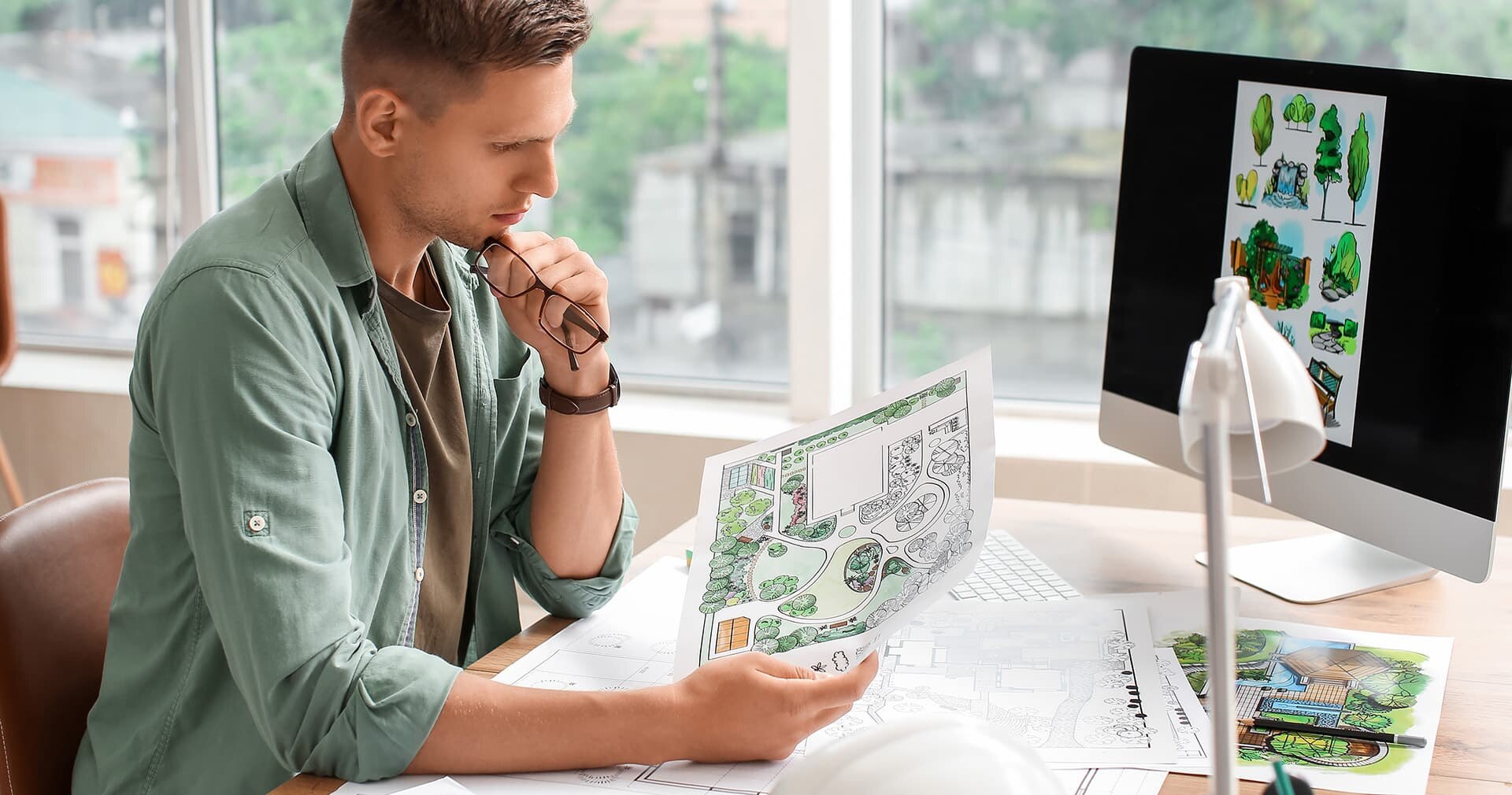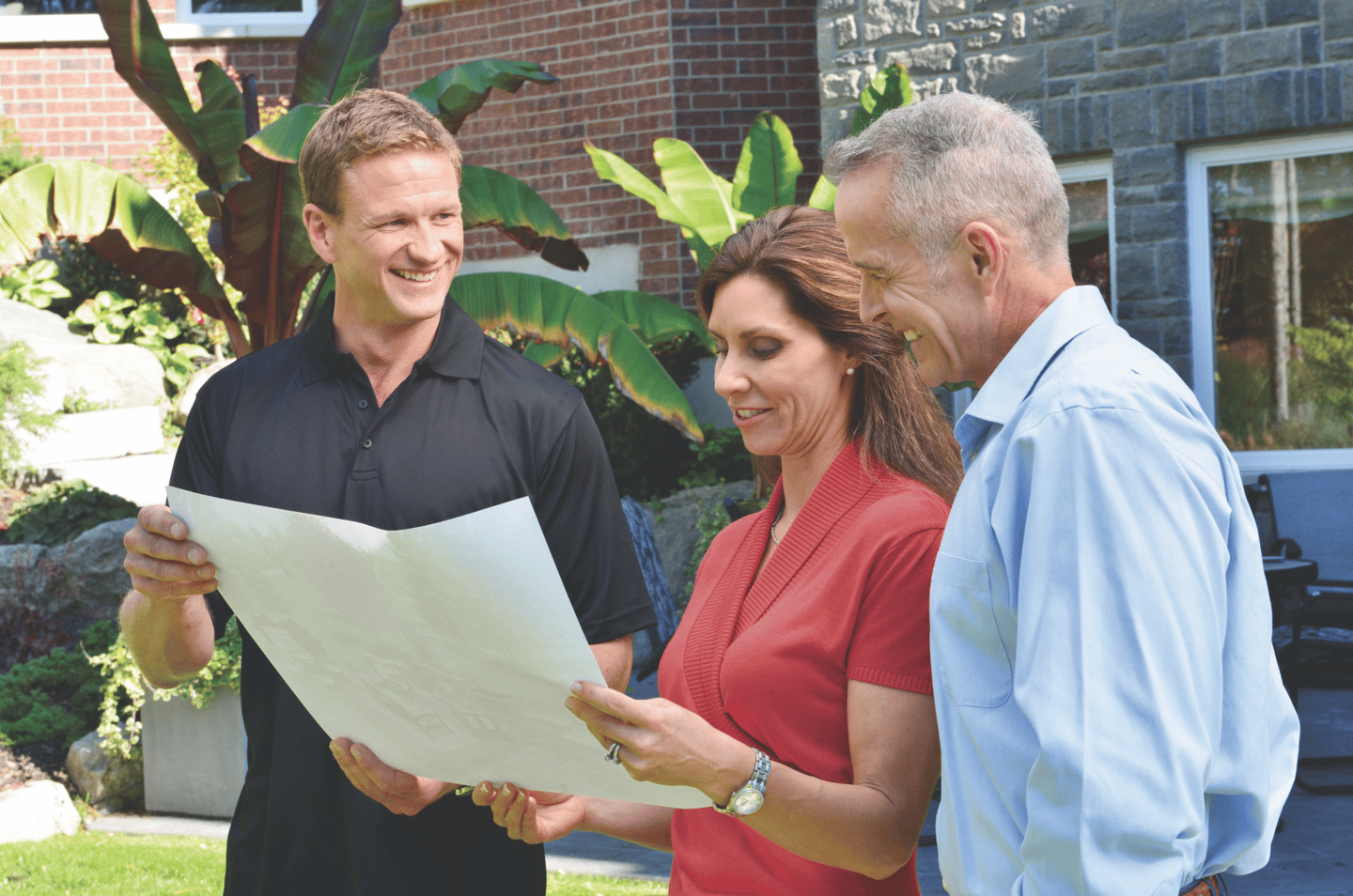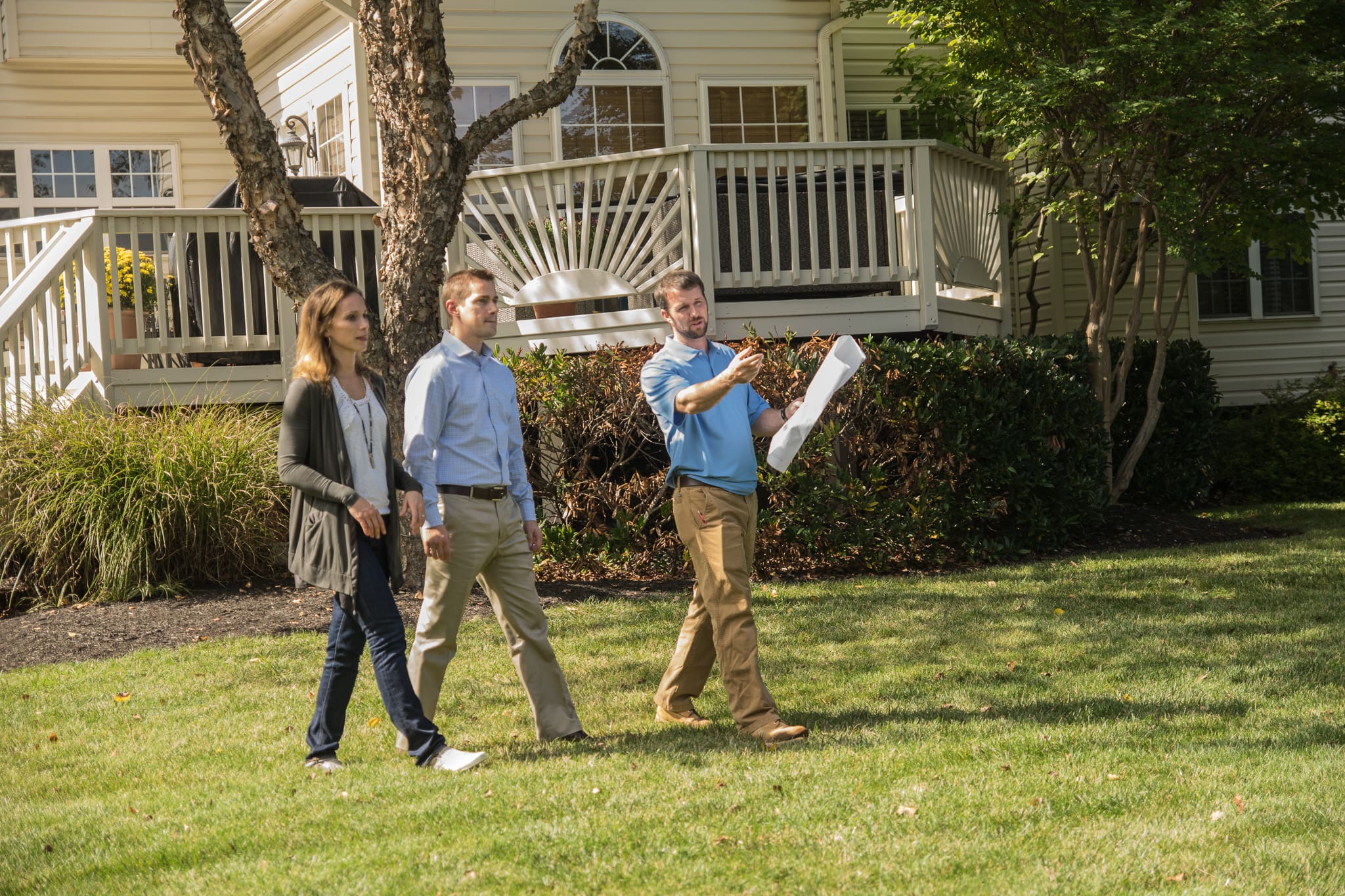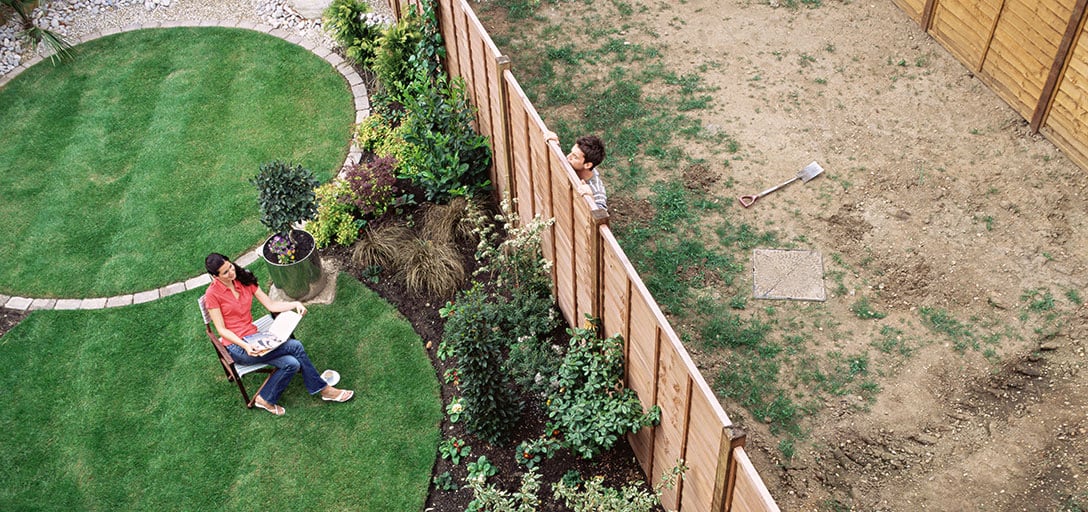What is the true value of a landscape designer or landscape architect?
April 29th, 2024
10 min read
By Andrew Whyte

Have you ever wondered, what does a landscape designer or landscape architect actually do? What is their role in ensuring you end up with the ideal garden you really want? How does the work of a designer influence the speed and ease of construction as well as the costs of your new garden? How do landscape designers pay for themselves many times over by giving you the garden you’ve been dreaming of?
After more than 30 years in the game we understand that when it comes to the work of landscape designers and landscape architects, some people seem to have the wrong idea about what design is and what designers do.
So we’ve written this article to help you better understand what landscape designers and landscape architects like ours actually do and why we value them so highly. (And why you should too!)
When you get to the end, we hope that you understand why every great garden starts with a great garden design. And that if you take the designer out of the process of creating a new garden, you can end up not just with a garden that won't match your dreams but in some cases one that could be an unworkable disaster.
First and foremost a landscape architect or landscape designer is completely indispensable to your new garden. You simply cannot create any new garden of any significant size or scope without it first being designed. That is true on both a practical and an aesthetic level.
But like many ‘creative’ activities, what design is and how it works is often completely misunderstood. Sometimes it is even seen as unnecessary or an ‘indulgence’. Yet time and time again we see that good design pays for itself many times over.
Design isn’t just all ‘airy fairy’ and about aesthetics or being ‘creative’ although this is an important element too. And it’s not just about saying where things go either.
Over the years we’ve had many clients come to us with a ‘design’ they’ve done for their new garden. They pull out a sheet of paper with some sketches on it and say to us - “well you see the pool goes here and the deck goes there and the outdoor kitchen goes over there and then there’s a path through the garden beds here”.
We have to be very diplomatic when we say “Thanks, that’s a great brief for our designer to work with - but it’s not actually a design!”
Design is much more than just grabbing a sheet of paper and sketching out a plan with all the elements of a new garden in their places.
If it was that simple, anyone could do it.
Because design is much more than just organising or arranging all the elements of a garden in a visually pleasing manner. They must function and work together as a cohesive whole as well. Additionally, they must comply with council and other regulations. Also, they have to have been designed so they can actually be built and not at an outrageous cost.
The truth is that a landscaper cannot start work on constructing a garden until they have a design or a plan to work to. (If it’s just a simple bit of landscaping like a couple of new garden beds, some new turf and maybe a water feature or path going in, you can get away with just a simple sketch or rough plan but even this is some sort of ‘design’. Anything more complex than just these few elements will need a design.)
There are literally hundreds of practical considerations every designer has to make before they even get into the aesthetics of designing the garden.
The site – the very beginning
When a landscape architect or designer comes to visit your site for the very first time, their mind is working overtime, taking note of dozens of things as they walk around the site. Things that you may never have noticed or even thought about.
But all these will become, for them as garden designers, critical factors that can influence their design thinking. Factors like:
- the layout and orientation of the site
- if the site is flat, sloped, stepped or undulating
- the existing architecture and footprint of the house
- the style of the house – is it modern or period?
- the type of décor inside the house
- the overall ‘vibe’ of the house
- the position of windows and internal views
- the floor levels of the house
- the main entrances to the house and access routes
- any existing landscape elements that need to be incorporated
- any neighbouring buildings or large trees, particularly if they overshadow or overlook the property
- any easements or services or assets that run through the property (water, sewer, power, etc)
- if the property is impacted by any council overlays such as heritage overlays etc
Additionally, the designer of the garden will often consider how the proposed new garden will sit within the broader context of the surrounding landscape. Are there nature reserves, beaches or parks nearby? How will their biodiversity of them influence or affect the flora and fauna within the new garden? (Both the garden and broader landscape are not independent of each other.)
It’s not about the garden!
After visiting the site the next thing a landscape designer or landscape architect will start thinking about is NOT the garden. It’s you, the client.
In many ways, designing your garden is not about the garden at all. It’s about the people who will live with and enjoy the garden.
So a good designer will start by thinking about you, your family, your lifestyle, and possibly even your friends.
They will ask themselves what kind of people you are and how do you live your lives.
Are you active people, living a busy social life with many friends and a big family network?
Or are you the more passive, chilled and relaxed type of people who seek solitude, privacy and contemplation?
Obviously, these two different types of clients would produce two entirely different sorts of gardens.
Then they will assess practical considerations like:
- How big is your family?
- Do you have any kids?
- If so how many and how old are they?
- Do you have any pets?
- What type of pets and how important are they to the family?
But they may go even deeper into assessing other aspects of a client’s personality like:
- Are they perfectionists?
- Do they like order?
- Are they formal or relaxed?
- Do they have hobbies like cooking, golf, or maybe gardening?
- Where do they tend to holiday or travel to?
- What do they like about the places they visit and is there something about that which could be worked into the garden design?
- Are they looking for a garden to give them status?
All these things start to paint a picture and provide clues to the designer about what they need to consider in order to create a space that makes sense to you, the client. These can also influence the key shapes in a garden and what elements might work well for you, even if you didn’t ask for them in the brief.
For example, someone with a fast-paced hectic life might need a garden with some curves in it to soothe and relax them. A perfectionist might think they need a garden with order and straight lines, however, they may also benefit from a softening of their garden to prevent it being too ‘controlled’ and to help them relax a bit. A homebody may enjoy a nice big vegetable patch.
In the end, many designers see the design of a garden or a landscape as an opportunity to bring families and friends together. To enable individuals to connect with themselves and each other and to connect with the environment. A garden should be a place of joy, happiness, pleasure and healing. A place to rest, relax and rejuvenate. To recover from the sometimes arduous aspects of daily life.
Ultimately landscape design is about the designer trying to understand what is this garden trying to be and who is it trying to be that for?
Your wish list
When your landscape designer or landscape architect sits down with you and takes a ‘brief’ on what you want in your garden, the conversation will generally include a ‘wish list’ of all the elements you want in your ideal garden.
- Do you want a pool, a deck, an outdoor kitchen?
- Would you like a pergola, a gazebo or a verandah?
- What sort of garden beds and plants were you thinking?
- Do you want a lawn or something more low maintenance?
- What style of garden did you have in mind?
- Are there any ‘must haves’ or, just as importantly, any ‘must not haves’?
Once your garden designer has visited your site, gathered all the relevant information and assessed your personal needs they will take your wish list and start thinking about how they will compose your garden. They will need to do it in a way that links all of the practical constraints of the site with the innate qualities of the broader landscape and what you and your family actually value.
When briefing your designer we urge you not to limit your goals. We urge you to think and dream big. It’s better for the designer to know all your biggest aspirations at the start, even if you might need to compromise on them later. Because your landscape designer or landscape architect might just be able to come up with clever ways for you to actually have them all.
But if you limit yourself in your thinking, you might rob yourself of having something wonderful included in your garden that might just make it special.
Big things come first
Generally, when starting the design work, most designers will begin with the ‘big ticket’ items first, like the pool, the deck or the pergola.
Often they will ask themselves questions like:
- What are the reasons for it to be there in the first place?
- What will it provide for everyone using the garden?
- Where should it go?
- Why should it go there and not somewhere else?
- What role will it play in the client’s enjoyment of the garden?
- How will it work with other elements in the garden?
- Should it dominate the landscape or play a supporting role?
- How will it enable or influence people to move through the landscape?
- Are there any other options available for how we could do it differently?
The answers to these questions will heavily influence the designer as they go about designing your garden. They will influence the style of the garden, the balance of the garden, and the way the garden functions.
While many people will tend to focus on the feature items in a garden like the pool, too much focus on this item at the expense of everything else can lead people to have a false perception of the proposed garden.
The most common error people make is to think that a landscape is simply what is put around the pool once it goes in, when in actual fact a pool is placed into a landscape that has already been designed and created for it.
Making your new garden function well
A great garden not only has to look good it has to function well too. Because a garden is not just something to be looked at and admired, it is also something you participate in.
There is nothing worse than a garden that is beautiful but has aspects that annoy you.
For example, if your garden is poorly designed from a functional point of view you might find yourself going “Oh why did we put that there?”. It can be so annoying to have to walk around the pool every time you want to access something that should have been closer to the house in the first place. And if you get a major element like that wrong, you will ‘have to live with it’ for life because you can’t move a pool!
A well-designed garden has a smooth flow to it. You can move from one end of it to the other easily. The zones merge from one into the other – for example, the pool merges well with the deck which then flows effortlessly into the alfresco dining area and outdoor kitchen.
When designing your garden, this is one of the many things that your landscape designer or landscape architect will take into consideration. They will look at the ‘flow lines’ of the garden and how their design will enable people to engage easily with the landscape and get the most enjoyment and pleasure out of it.
Negotiating challenging rules and regulations
If there’s one word that is bound to bring you down about your new landscaping project it’s ‘permits’. Whether from the council or other regulatory bodies, permits can be a minefield. Negotiating your way around them can be challenging.
But this is where the knowledge and experience of your designer can help enormously. Because they have designed so many gardens in the past they are familiar with the workings of the permit system and what things are likely to cause problems with getting a design approved.
So they can design around these issues or even try to avoid them.
This can save you an enormous amount of angst, particularly if you have already decided you want the pool to go “there” or the pergola to go “right here” or the deck to be at such and such a height. In many cases, your designer can tell you straight away why things might not actually be possible in the way you imagined them because of permits or other restrictions.
For example, the pool might not be able to be built that close to an easement for a certain reason so it will have to be moved or be possibly smaller.
Or the pergola can’t go where you want it to because it will be too close to the fence and the council won’t approve that.
Or the deck can’t be that high or it will cause ‘overlooking issues’ with the neighbours.
A good designer can steer you away from these problems right from the start. Often they can then propose better and smarter alternatives that won’t lead to big delays on the project or additional costs. Alternatives you might never have thought of if you were trying to ‘design’ the garden yourself.
And when it comes to actually applying for the permits, a good landscape designer or landscape architect can also play an important role.
Often the success of a permit is not what you ask for but how you ask for it.
If all your permit submission paperwork is in good order and the design is done well and according to all the standards, this can help the application sail through.
But when individuals try to get their own council permit applications through, they can often run into the fact that the person approving the permit can be uncertain that you actually know what you are doing and will follow all the rules and regulations properly. After all, that’s all they’re trying to enforce – that you will build things according to the expected standards.
However, when an application has been prepared and submitted by a professional landscape design & construction company that knows and understands all the rules and what the approver will be looking for, it is more likely to be approved without delay or major changes.
How great designers pay for themselves
Ultimately a good landscape designer or architect pays for themselves many times over.
They do so by fully recognising the challenges and opportunities your site presents. And by really understanding you and your family’s needs.
They do so by appreciating how all the elements on your wish list will look together and how they will function with each other.
They do so by designing a garden that can be built quickly and easily without too many delays or complications.
And they help you overcome the challenges of rules and regulations that councils and other regulatory bodies may impose on you.
Often designers will also add value by including surprising new elements in your garden design that you weren’t expecting but you fall in love with. Or give you a twist on something you wanted but would never have thought of yourself.
Because often the real value of a good landscape designer or landscape architect is their ability to think outside the box and come up with creative solutions to the challenges you face because of limited space, budget limitations or other restrictions.
There is nothing more rewarding for us and you, than to receive a well-thought-out and well-conceived garden design that exceeds your expectations. One that leads to an exciting and beautiful new garden being built that you will enjoy for decades to come.
If you’d like to discover how the designers at Whyte Gardens could create the garden of your dreams for you, please book a free, no-obligation discovery call with one of our talented design team. And let them put their design magic to work for you.
Articles covering Landscape Design and Construction in Melbourne...
Is Whyte Gardens the right choice to landscape your garden?
What's included in a landscape designer's Master Plan?
When do you need to engage a landscape designer?
Founder of Whyte Gardens
Topics:





